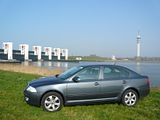
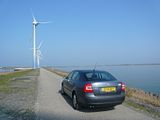
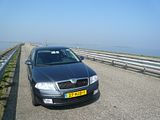
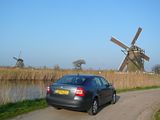
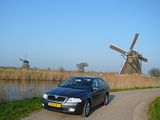
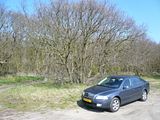

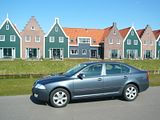
With the launch of the Skoda Octavia, back in 1996, any of the remaining jokes about Skoda’s cars left over from the communist era products were finally put to rest. This car, based on the VW Golf, though only the cognoscenti would know it, impressed not just with its fine value for money, but also for its roominess, performance and general ability to meet the needs of many a family in all markets where it was sold. Initially offered with a variety of petrol and diesel engines, in hatchback and estate versions, the range was augmented by the vRS cars which delighted everyone with their performance, and were unbeatable value. It was little surprise that the second generation model deviated little from the same formula, still based on the latest Golf platform, and sharing much from the VAG parts bin, including a wide range of engines, but clothed in a body which superficially looks little different from the older car, but a closer inspection reveals that it shares nothing. It is a measure of success in ridding Skoda of those age-old jokes that I was offered the latest test car, a Dutch spec Octavia 1.9 TDi hatchback as an upgrade to the Golf which I had booked.

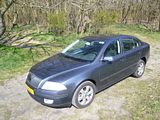
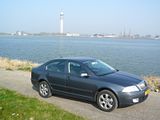

I had previously driven an Octavia – the last one was a petrol engined estate car, and I had found it really rather impressive, so I had high hopes for this one. With just “Diesel” written on the paperwork and the key fob, and a simple all black lettered TDi badge on the car, I was initially unsure whether I had the older Pumpe Duese 1.9 engine or the later and markedly more refined 2.0 unit. One crank of the engine, and I had little doubt! I was able to confirm, when I found a sticker under the bonnet saying that this was the 77kW engine (that equates to 103 bhp), that this was indeed the older engine. And what a shame it is still being used, as this has to rate as one of the noisier diesel motors in current production. The clatter at start up is particularly troublesome, and at idle and low speed, it does not get aurally any better. Once on the move, though, things do improve. A lot. Not only does the engine quieten down to better than acceptable levels, but it pulls well, with lots of low down torque giving a quick burst of acceleration, a feature which proved particularly useful when trying to avoid irritating too many Brussels drivers (a feat that is almost impossible, as they make the Italians looks like amateurs in using the horn!). With only 103 bhp in what is quite a large and heavy car, ultimately, this engine runs out of oomph, for sure, though on the speed camera infested roads of the Netherlands, you would probably never get the chance to find out! You also never really come across hills there, so it is fair to say that the performance of the car – one up, only – got less tested than is sometimes the case. It certainly did not embarrass or even frustrate me, accepting that the red line is at 4500 rpm, but your ears and some semblance of mechanical sympathy have probably encouraged you to change up earlier than that, especially as the torque cuts in from much lower down the rev range. The engine does deliver good economy, though. Most of the test mileage was conducted at steady speed on Dutch motorways (well populated with speed cameras), so I accept that the figures I got were probably about as good as you would ever see. Nonetheless, at an average of just 4.6 l/100km, equating to 61.7mpg. I did notice that the emissions rating for this engine is notably better than that achieved by the admittedly more powerful 2.0 TDi engine.
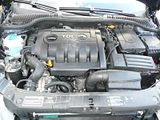
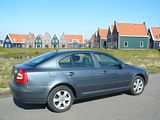

One other disappointing feature in the driving experience, and again, no surprise, given the VAG parentage: the gearbox. Although the quality of the gearchange would not win prizes, selecting between any of the 5 forward speeds is not the issue, with a slightly clunky change, but one which never takes you into the wrong gear, and actually does not feel that different to that experienced in the Ford Focus. The problem is reverse. It is engaged by pulling the lever to the left of first, pushing the lever down then slotting it alongside first gear. Although it did nearly always engage, it often felt that it had not. I have to say that the quality of this feature reminded me of my first Audi S4 and even the VW gearbox-ed Montego I had, neither of which would have won prizes for their gearchange quality! Dynamically, otherwise, the Octavia drives well. It’s a family-missioned front wheel drive hatchback, so you would expect no surprises and ultimately not that much “fun” and that is exactly what you get. The steering is light, without being totally feel-less, the car handles well, with just a very slight touch of understeer on some of the sharper motorway intersection curves (about the nearest I have got to finding any bends, which are in shorter supply than hills in Holland, it seems!). One benefit of the relatively long wheelbase is that the car rides well, even on those dubious Belgian autoroutes (the ones with the “spur vormig” signs every few miles, reminding you of the effects of a pounding from heavy lorries!). At cruising speed, it is actually quite relaxed, though I can’t help feel that a sixth gear would make it even more so. No issues with the brakes, not that they got much of a hard test. One consequence of the quite steeply sloped rear window is that judging the rear extremities of the Octavia was not as easy as is the case with most hatchbacks, so parking in tight spaces was not that easy. Otherwise, visibility was generally good.
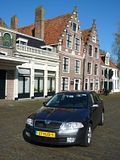
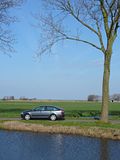
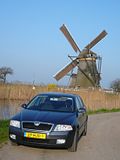

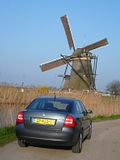
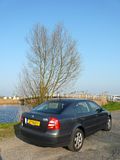
No quibbles about the interior finish. This might be at the bottom of the VAG “pecking order”, but the quality of the trim and materials is far from budget spec. Indeed, it is all done rather well, and in good taste. The plastics used for the dash mouldings are soft and of excellent quality, with a far nicer texture than you see in many cars these days. There is a simple strip of aluminium effect plastic across the dash and door trims which lightens the ambience somewhat, without appearing over garish (Ford, take note!). The main instrument binnacle comprises two large instruments – speedo and rev counter, with just two smaller gauges above, for fuel and water temperature. There is a small display for trip computer functions between the main dials, and you can toggle between two sets of readings by pushing a button in the bottom of the indicator stalk. I never did work out how to change the clock, though, and as it was a rental car, there was no handbook. It would doubtless have been in Dutch anyway. The seats are trimmed in a hard-wearing sort of weave material, and, with height adjustment as well as the expected fore/aft and backrest tilt, they proved very comfortable on a relatively long journey to Brussels and back.
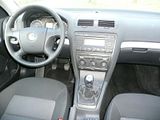
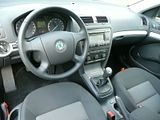
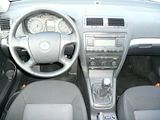
The test car, which was a Dutch spec model, came with what would appear a slightly odd combination of features present, and those missing. It has cruise control, for instance, operated by functions on the left hand column stalk, and it features full climate control, which was effective at taking the chill off a frosty start or two, but it does not have a rear wiper, which was a decided nuisance when faced with a condensation laden car, no scraper and the need to reverse it out of the hotel parking slot. The heated rear window did the job quite quickly for me, though. Faster than I was able to clear the front screen. One feature which has spoiled me on some cars is the link of the rear window heater to the door mirrors, but you don’t get that on this car, either, sadly. You do get a good quality, and simple to use stereo system, with single slot CD, mounted in the middle of the dash, which proved easy to use.
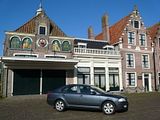
As the Octavia is intended to be used largely as a family car, it is good to report that it seems to hit its objectives pretty well. For starters, this is a roomy car. Although based on the Golf platform, there is notably more room, especially in the rear seats, where accommodation levels meet or even exceed those of the class above. There is a huge boot space, too, which can be extended by folding the asymmetrically split rear seats, which drop onto the space vacated by lifting the rear seat cushions. Height of the boot area is limited by the sloping rear window line, but there is still plenty of space in this car, and should even more be needed, Skoda do always offer the estate car. Inside the passenger compartment, there are plenty of useful storage areas, with door bins, a centre cubby under the armrest, moulded slots which could be the base for cup holders in the central console and a reasonable sized glove box, as well as deep bin above the driver’s knee and a small lidded compartment on the top of the centre of the dash.

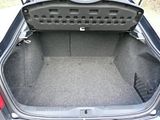
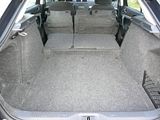
On balance, the Octavia is indeed a very good car, spoiled by that noisy engine and the recalcitrant gearbox. I doubt that the recently available facelifted cars address either of these points. However, there are other engine options available, and these would perhaps be the ones to pick. Get the right combination, and this would make excellent family transport indeed.
































